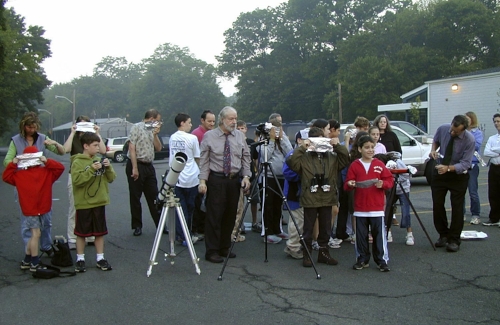At 6 AM on the morning of June 8, 2004, a group of Rye Neck middle and high school students, along with some of their parents, gathered with me at the gym parking lot to witness a Transit of Venus. I had scoped out the area in advance and figured it was probably the best place on the school grounds to view the event. There was a clear view of the east and only some distant trees just above the horizon.
It was rather hazy and gray, but the rising sun was visible through the scattered clouds and mist. The sun had just cleared the distant trees by about 6:45, and the black dot that was Venus was easily seen with Mylar-protected eyes and binoculars. The transit was well under way and almost over when we, on the east coast, got to see it. By 7:20 AM, the little dot had made its way across the lower right area of the sun, got to the edge of it, and disappeared from view.
It was quite a thrill, and, for many of them there, it may have been a once-in-a-lifetime thrill. But the way it works with Transits of Venus is that they come in pairs, eight years apart. And then not again for 105 years. The last Transit of Venus was in 1882. So, after the transit, and before we all went to school extra early that day, I told everyone in the parking, and all my classes, that, if we were lucky enough to be around in eight years, and weather permitting, I would meet with them again on June 5, 2012.
And that day came to pass.
I had been retired from teaching at Rye Neck for five years, but, thanks to Facebook, I was still connected to a number of old students. Of course most of them, eight years later, had already graduated, but a few of them texted me about the second transit. I announced on Facebook that a day or two before the event I would post a time and a place to meet ... again weather permitting.
But on that day, the weather did not permit. It was mostly cloudy on the 5th, from early in the morning, and all day long it was mostly cloudy and sometimes overcast with a chance of rain. What made matters even more problematic was the fact that the transit would not start until 6:20 PM and would still be in progress when the sun set about an hour and a half later. So, even if skies cleared a bit, we would only have a very small "window of opportunity." Although the transit was certainly going to happen, I posted that this one would have to take place without anyone seeing it from Westchester or anywhere else in the clouded-over tri-state area. Of course I was disappointed, but I had already seen one Venus transit and was thankful for that.
At about 6 PM, I started to make dinner. As I was busy in the kitchen, I saw through the west-facing window an unmistakable shaft of light. There was a bright, yellowish flash, and sharp shadows fell in the house for the first time that day. It didn't last for more than a few seconds, but I knew that there must be a break in the clouds.
I dropped everything, put my camera and the telescope in the car, and headed quickly to my favorite view of the western sky at the Rye Ridge Shopping Center. Five minutes later I was there.
Clouds obscured the sun, but I pointed the 'scope where the sun should be, focused on the clouds, got the camera ready, and waited. For ten minutes, from 6:32 to 6:42. Then, through a veil of clouds, the sun broke through. For the next ten minutes the setting sun broke in and out of the clouds, but I was able to take 30 pictures.
As in the image from eight years before, the clouds were clearly visible. That may not be ideal for scientific astrophotography, but I like so much the reminder that the image was taken from the earth... through the moving clouds of a living planet.
All in all, I was very lucky to get this picture… and luckier still to be able to see and record both of this century's transits of Venus. The next twin transits will be visible from earth in 2117 and 2125.
Now here's a transit story that makes me feel even luckier.




